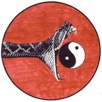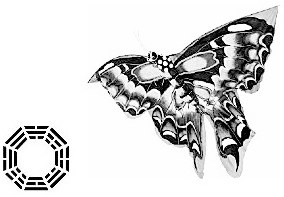
MONSTERMARTIALARTS.COM
The Source of the True Art!

In Three Easy Steps!
The first thing you are going to have to overcome is the idea that it takes decades to learn such arts as Tai Chi Chuan or Pa Kua Chang or Aikido. Look, the army makes soldiers in three months, and that includes some high tech stuff. And, when you add up the actual hours spent on that college course, it doesn't take that long to make a scientist or mathematician.
The idea that it takes long stretches of time is something that has been taught to us by people who want to make money. After all, the longer somebody is engaged in a course of study, the longer money goes into that cultural dojo box. So get over the idea that it takes a lifetime, and get used to learning fast!
Now, to learn an art such as pa kua chang you need to draw a circle about six feet across, and which takes exactly eight steps to step around. You need to situate the circle so it is squarely in the room, which means that if you straightened up every two steps you would face a wall. Now you need to schedule a three day weekend to master this thing.
The first rule in walking the circle is to keep the hips low and move them at an even rate of speed. The second rule is to breath evenly and synchronize the movements of your hands and feet so they move at the same rate of speed, starting and finishing techniques at the same time. The third rule is to be willing to isolate yourself as separate from the regular universe, let your attention slide off the tables and chairs, the trees and fences, as you walk around and around.
Now, you need basics that actually work. Examine an art such as karate for basic blocks, and curve the arms to adapt them to a circular art such as Pa Kua Chang. Things can get complex pretty quickly, so you might consider taking the four basic blocks, hi, low, in and out, and working with them to start.
Now take a step on the circle and do a block, making the largest circles you can make with a basic block. Though you have only taken one step, let your body turn to the maximum, and don't let the block finish until you have reached the endpoint. When you reach the end of the turn, reverse your turn and start a long and slow second block. Take a step with that second turn and block, and, again, let your body turn to the maximum.
Keeping the hips tucked under will help you avoid injury to the lower spine, place the feet flat and seek total stability, and search for graceful movements. Be a ninja ice dancing, slowly whirling and spinning, exploring the limits of motion. Ignore anything that looks even remotely like a self-doubt, and let a few hours expose the truth of Pa Kua Chang to you.
The last thing is to make sure what you are doing actually works as a martial art, because if it doesn't work you shouldn't be doing it. Have a friend try slow attack movements on you, and walk a small circle around his attacks, letting your blocks encircle his limbs, and you will find all sorts of odd but useful techniques. Now, the one thing you should know, the one thing that will make all the difference...this is exactly how such arts as Tai Chi, Pa Kua and Aikido were invented in the first place!
MENU
RESOURCES
PACKAGES
COURSES
MORE STUFF